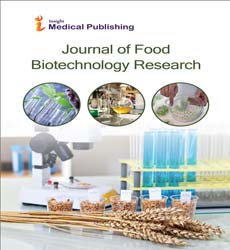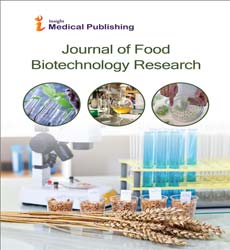Microbiological Treatment of Food Waste
Lei Yan*
College of Life Science and Biotechnology, Heilongjiang Bayi Agricultural University (HBAU), Daqing, Heilongjiang Province, P.R. China
- *Corresponding Author:
- Lei Yan
College of Life Science and Biotechnology
Heilongjiang Bayi Agricultural University (HBAU)
Daqing, Heilongjiang Province, P.R. China
Tel: (+86)0459-6819299-810
E-mail: hekouyanlei@gmail.com
Received Date: October 12, 2017; Accepted Date: October 12, 2017; Published Date: October 18, 2017
Citation: Yan L (2017) Microbiological Treatment of Food Waste. J food Biotechnol Res. Vol.1 No.1:2
Editorial
Food waste (FW) is organic materials discharged from food processing plants, kitchens, cafeterias and restaurants [1]. Generally, FW waste includes fruits and vegetable peelings and residues, fish and poultry residues and bones, food fats, sauces, condiments, soup pulp, herbal medicinal pulp, cereals of all types such as rice, noodles, oats, plate scrapings and leftover of cooked food, barbecue raw or cooked leftovers, and pet foods [2]. FW which is discarded globally without any further use almost account to one third of the worldwide food produced for the human consumption [3]. The discarded FW have caused serious environmental problems such as water pollution, pathogen breeding and odor diffusing. Actually, FW is a renewable resource which is considered as a reservoir of carbohydrate polymers, lipids, proteins, and nutraceuticals and can form the raw materials for commercially important metabolites [4]. Traditional technologies to treat FW such as landfill and incineration have become less desirable due to current legislation or causing secondary pollution [4,5]. As an alternative method, microbiological treatment of FW has become a hot topic for processing FW in recent years. Using microorganism, FW can be transformed to liquid biofuels including biodiesel, bioethanol, butanol, gaseous biofuels such as biogas and hydrogen, bioplastics including polyhydroxyalkanoate (PHA) and poly-3-hydroxybutyrate (PHB), industrial enzymes, electricity and microbe organic fertilizers.
Therefore, the contents of FW microbiological treatment field are as follows:
(1) Biotransformation of FW to biofuels using microorganism.
(2) Producing environmentally benign and green bioplastics by microbes.
(3) The production of industrial enzymes via microbiological processing.
(4) Bioconversion of FW to electricity by microorganism.
(5) Producing microbe organic fertilizers via composting.
FW can be converted to biofuels including biodiesel, bioethanol, butanol, biogas and hydrogen. It can be used as raw material for fatty acids and biodiesel production by the transesterification of microbial oils produced by various oleaginous microorganisms. The microbial enzymes have also been used for biodiesel production. FW is regarded as alternative substrates for ethanol production via fed-batch and simultaneous saccharification and fermentation methods. Various strategies have been used to improve ethanol yield such as use of ethanol-tolerant strains, immobilized cell and recombination strains [1]. The hydrogen production potential of carbohydrate in FW is high and various fermentation systems including batch, semi-continuous, continuous, one or multiple stages, photo-fermentation or combined dark- and photo-fermentation system have been successfully applied in hydrogen production. The production of biogas, particularly methane has been achieved via single stage anaerobic digestion, two-stage anaerobic digestion, packed bed reactors or fixed bed systems [4].
Polyhydroxyalkanoate (PHA) and poly-3-hydroxybutyrate (PHB) are perfect replacements for petroleum-derived plastics. FW has been used to produce PHA and PHB using various microorganisms. FW is considered as an ideal candidate for enzyme production via fermentation in bioreactor which can replicate the natural condition. Electricity generation was obtained via microbial fuel cell with FW as substrates [5]. Composting is regarded as a suitable method for disposing solid FW. The process control strategies, such as proportional control, integral control, and different control techniques have been used to improve the efficiency of composting [6,7].
As an attractive technology, microbiological treatment has potential for conversion FW to energy, enzyme, bio fertilizer and biomaterials [1]. The future study on this field will focus on the improvement of output efficiency and decrease of cost for these products via screening new strains and exploring new process.
References
- Kiran EU, Trzcinski AP, Ng JW, Liu Y (2014) Bioconversion of food waste to energy: A review. Fuel 134: 389-399.
- KarmeeSK (2016)Liquid biofuels from food waste: Current trends, prospect and limitation. Renew Sustainable Energy Rev53: 945-953.
- Girotto F, Alibardi L, Cossu R (2015) Food waste generation and industrial uses: A review. Waste Manag 45: 32-41.
- Ravindran R, Jaiswal AK (2016) Exploitation of food industry waste for high-value products. Trends Biotechnol 34: 58-69.
- Jia J, Tang Y, Liu B, Wu D, Ren N, et al. (2013) Electricity generation from food wastes and microbial community structure in microbial fuel cells. Bioresour Technol 144: 94-99.
- Li Z, Lu H, Ren L, He L (2013) Experimental and modeling approaches for food waste composting: A review. Chemosphere 93: 1247-1257.
- Ismail SS,Muttalib SAA, Praveena SM (2016) Application of effective microorganism (EM) in food waste composting: A review. Asia Pacific Environmental and Occupational Health Journal 2: 37-47.

Open Access Journals
- Aquaculture & Veterinary Science
- Chemistry & Chemical Sciences
- Clinical Sciences
- Engineering
- General Science
- Genetics & Molecular Biology
- Health Care & Nursing
- Immunology & Microbiology
- Materials Science
- Mathematics & Physics
- Medical Sciences
- Neurology & Psychiatry
- Oncology & Cancer Science
- Pharmaceutical Sciences
